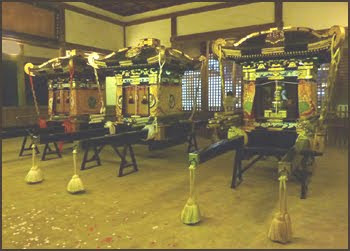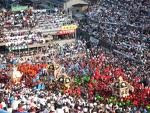[ . BACK to WORLDKIGO TOP . ]
:::::::::::::::::::::::::::::::::::::::::::::::::::::::::::::::::::::::::::::::::::::::::::::::::::
Retreat (ango)
***** Location: Japan
***** Season: Various, see below
***** Category: Observance
*****************************
Explanation
kigo for all summer
ango 安吾 (あんご) intensive retreat
(for monks , priests and sometimes laymen)
Skt varsha or varshika; Pali vassa;
tranquil dwelling, spiritual retreat
 source : zenbunka.or.jp
source : zenbunka.or.jp
natsu ango 夏安吾(げあんご)
summer retreat for monks
..... gegomori 夏籠(げごもり), gekomori
..... ge 夏(げ)
gegyoo 夏行(げぎょう)
ame ango 雨安吾(うあんご)retreat in the rain
angodera 安吾寺(あんごでら)temple for retreat
gezutome 夏勤(げづとめ)summer rituals
..... ketsuge 結夏(けつげ)
ge-iri 夏入(げいり)beginning the retreat
ketsusei, kessei 結制(けつせい)
ichige 一夏(いちげ)lit. "one summer retreat"
ge hyakunichi 夏百日(げひゃくにち)100 days retreat
.... hyakunichi no gyoo 百日の行(ひゃくにちのぎょう)
ge no hajime 夏の始め(げのはじめ)beginning of the retreat
ichige kujun 一夏九旬(いちげくじゅん)
zen ango 前安吾(ぜんあんご)beginning of the retreat
chuu ango 中安吾(ちゅうあんご)middle of the retreat
go ango 後安吾(ごあんご)ending of the retreat
ge no owari 夏の終り(げのおわり)end of the retreat
gedachi 夏断 (げだち)
"summer abstinence"
not eating red meat, not drinking alcohol, staying home reading the sutras and copying them.
. gekyoo 夏経(げきょう) copying the sutras in summer .
gegaki 夏書 (げがき) "writing in summer"
shakyoo-e 写経会 meeting to copy sutras
gebana 夏花
"summer flowers" as offerings on the altar
..... gebana tsumi 夏花摘み(げばなつみ)picking flowers for offerings
during the ango retreat
Every day new flowers are offered.
This is done at the temples, but can also be done at home for the family altar.
The origin of this custom dates back to the Heian period, where offerings were made at the Western Tower of temple HieiZan, Kyoto.
比叡山西塔院
:::::::::::::::::::::::::::::::::::::::::::::::::::::::::::::::::::::::::::::::::::::::::::::::::::
kigo for early autumn
. gege 解夏 end of the summer ascetics .
..... ge aki 夏明き(げあき), ge no hate 夏の果(げのはて)
..... sooan, soo-an 送行(そうあん)
..... gegaki osame 夏書納(げがきおさめ)
..... butsukangibi, butsu kangi bi 仏歓喜日(ぶつかんぎび)
..... kangibi 歓喜日 "a day to rejoice"
:::::::::::::::::::::::::::::::::::::::::::::::::::::::::::::::::::::::::::::::::::::::::::::::::::
kigo for all winter
. Fuyu Ango 冬安居 Winter Retreat for Monks
yuki ango 雪安居(ゆきあんご) retreat for monks in snow
:::::::::::::::::::::::::::::::::::::::::::::::::::::::::::::::::::::::::::::::::::::::::::::::::::::
An, ango (安居), or kessei (結制),
is a Japanese term for a three-month period of intense training for students of Zen Buddhism, lasting anywhere from 90 to 100 days.The practice during ango consists of meditation (zazen), study, and work (samu).
Ango is typically held twice a year, the first period from spring to summer and the second period from fall to winter. The word ango literally translates as "dwelling in peace"; the summer ango is referred to as
ge-ango and the winter period is
u-ango.
Additionally, some monasteries and Zen centers hold just one ango per year.
Concerning Zen practice in the United States, author Ellen Birx writes,
"Many centers now allow members to attend retreats on a part-time basis. Many have ango, a three-month long period of intensified practice, that members can participate in while continuing to go off to work during the day."
Taigen Dan Leighton writes a more traditional definition, "These are ninety-day training periods of concentrated practice without leaving the monastic enclosure (except for monks going out for necessary temple business). They date back to the summer rainy season retreats of Shakyamuni's time. In Japan, they have been held twice a year, summer and winter."
© More in the WIKIPEDIA !
komorido 籠人 / 籠り人
person retreating in a hall for religious practice
*****************************
Worldwide use
*****************************
Things found on the way
*****************************
HAIKU
しばらくは瀧にこもるや夏の初め
shibaraku wa taki ni komoru ya ge no hajime
for a while
I will sit behind the waterfall -
summer retreat begins
Matsuo Basho 松尾芭蕉
On May 20,year 元禄2年4月2日
 source : itoyo/basho
source : itoyo/basho
Urami no taki 裏見の滝 - 裏見の瀧 "Back- view waterfall"
near Nikko, with a cave behind the waterfall for mountain ascetic practises.
urami 恨み to hate, have a grudge,
ほととぎす裏見の滝の裏表
hototogisu Urami no Taki no ura omote
hototogisu -
Urami no Taki
with back and front
Written on the second day of the fourth lunar month, Genroku 2
元禄2年4月2日
When Basho spent time behind the waterfall, he could not hear the hototogisu any more and felt this as URAMI.
Placenames used by
. Matsuo Basho 松尾芭蕉 - Archives of the WKD .
Oku no Hosomichi
. Fudo Myo-O 不動明王 statue at Urami .
.............................................................................
 source : Yamada Naokimi
春の夜や籠り人ゆかし堂の隅
source : Yamada Naokimi
春の夜や籠り人ゆかし堂の隅
haru no yo ya komorido yukashi doo no sumi
this spring night -
a person mysteriously in retreat
in the temple corner
Tr. Gabi Greve
Spring 1688, at Hase 初瀬 (Hatsuse)
The temple in Hase is known from the Tales of Genji (Genji Monogatari), where ladies of the court came to pray to Kannon to find a suitable lover.
. Temple Hasedera 長谷寺 .
Oi no Kobumi 笈の小文
. Matsuo Basho 松尾芭蕉 - Archives of the WKD .
:::::::::::::::::::::::::::::::::::::::::::::::::::::::::::::::::::::::::::::::::::::::::::::::::::::::
gegaki, ge-gaki 夏書き copying the sutras during the retreat
natsukashiki ge-gaki no sumi no nioi kana
I remember so fondly
the smell of his ink
during summer retreat writing
at the 17th death anniversary of priest Watanabe Unriboo
渡辺雲裡坊
Watanabe Unribo Seihan (1692-1761)
from Owari
たもとして払ふ夏書の机哉
tamoto shite harau ge-gaki no tsukue kana
with her long kimono sleeve
she cleans the desk
for summer retreat writing . . .
. Yosa Buson 与謝蕪村 in Edo .
Buson also wrote this hokku when he met Seihan in Edo, making fun of their shaven heads:
水桶にうなづきあふや瓜茄子
mizu-oke ni unazuki-au ya uri nasubi
in the water tub
they nodd to each other
a melon and an eggplant
 source : www.rakanneko.jp
source : www.rakanneko.jp
:::::::::::::::::::::::::::::::::::::::::::::::::::::::::::::::::::::::::::::::::::::::::::::::::::::::
夏籠(げこもり)
 夏籠や畳にこぼすひとりごと
夏籠や畳にこぼすひとりごと
gekomori ya tatami ni kobosu hitorigoto
summer retreat -
my lonely mumblings tumble
on the tatami mats
草城句
source :
http://shahai.exblog.jp/4304632/
:::::::::::::::::::::::::::::::::::::::::::::::::::::::::::::::::::::::::::::::::::::::::::::::::::
わざわざに蝶も来て舞う夏花かな
wazawaza ni choo mo kite mau gebana kana
even the butterflies
come to dance here -
summer flower offerings
Tr. Gabi Greve
- - - - -
雪隠の歌も夏書の一ッ哉
setchin no uta mo ge-gaki no hitotsu kana
in the temple privy
this poem, too,
a true summer prayer
Tr. Chris Drake
This summer hokku is from the 4th month (May) in 1822, when the summer retreats (夏 ge, or 夏安居 ge-ango) are getting underway at various Buddhist temples. Following a custom that began in ancient India during the Buddha's lifetime, in Japan, too, monks and laypeople gather at temples and concentrate on prayer, chanting, meditation, and study during the rainy season in early summer. The retreats usually began on 4/8, the birthday of the Buddha, and could go on for as long as 90 or a hundred days. Issa seems to have visited a temple on 4/8 or a little later, and in the privy he sees a poem or poems brushed on the wall. Uta usually refers to a waka or a kyoka, a humorous "crazy waka," and it could be either one here.
Evidently the poem refers to one of the Buddhas or is inspired by Buddhism, since Issa takes it to be legitimate summer retreat writing (ge-gaki 夏書). Summer retreat writing usually referred to calligraphically writing the name of a Buddha, especially Amida, or to copying out sutras, but this humble poem, perhaps humorous, obviously expresses deep spirituality.
Chris Drake
. Kobayashi Issa 小林一茶 in Edo .
. WKD : Summer Flowers .
. Toilet, Outhouse (benjo, no setchin, toire) .
*****************************
Related words
*****
.SAIJIKI ... OBSERVANCES, FESTIVALS
Kigo for Summer
BACK : Top of this Saijiki
[ . BACK to WORLDKIGO . TOP . ]
:::::::::::::::::::::::::::::::::::::::::::::::::::::::::::::::::::::::::::::::::::::::::::::::::::::
























































